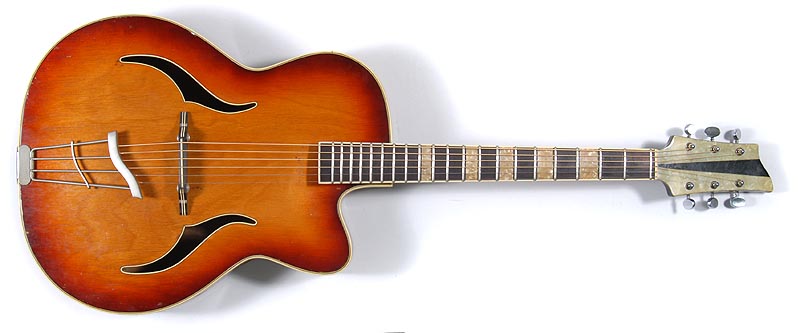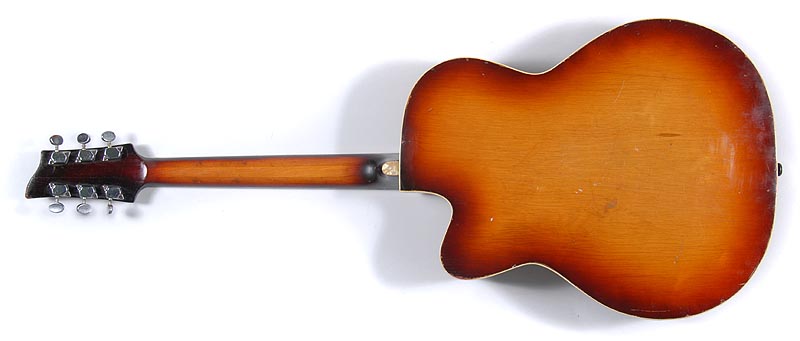

| I just love the design of some of the German archtop guitars from the 1940s and 1950s, and Framus was right up there in terms of design. To me, these stylised f-holes are the height of elegance! And even more so when couples with the sweeping tailpiece and headstock designs, and the liberal use of MOTS (mother-of-toilet-seat) pearloid plastics on the headstock face and position markers! While the guitar has no marks or brands to indicate it is a Framus rather than another German guitar, the design of the headstock and the f-holes make it virtually indisputable. Towards the bottom of the 'more pictures' page (link below) there is a picture of the cover of the Framus brochure of 1953/4, clearly showing these F-hole designs, and a photograph of the Framus booth at a 1950 Hanover trade show on page 45 of Dr Christian Hoyer's book, 'Framus - Built In The Heart Of Bavaria' clearly shows a similar guitar on display. Framus instruments only began to be fitted with labels and serial numbers in late 1959. This design of guitar became known as the Black Rose (even though Black Rose actually referred to a dark red-to-black sunburst finish), and a guitar customisation and building company by the name of Black Guitars in the UK does customised 'hot-rod' restorations of these Black Rose guitars for customers - click here to see one! This vintage archtop guitar probably dates from the early 1950s. Lack of serial numbers at the time makes accurate dating nearly impossible, but Framus guitars became a bit less adventurous with their designs as the decade progressed. The 1950s were very conservative years, after all! This guitar has been well played in its close to 60 years of life, but has plenty more years left. The wide frets are lowish, but still have several dressings left in them. There is evidence on the side of the guitar (treble side) of various scratch plate brackets or similar being mounted in the past, and the last section of neck projecting over the arched top shows evidence of a floating pickup once having been installed. The bottom picture in the 'more pictures' link below shows a Schaller pickup/scratchplate/control assembly, which is almost certainly what this guitar was once fitted with, as the marks and filled holes on the guitar match exactly. There is now no scratchplate on the guitar. The guitar is very playable, especially with a more enthusiastic or heavy-strumming style, as the action is not super-low. The neck (no truss rod) has a very slight bow which gives plenty of relief, allowing heavy strumming. The adjustable bridge can still be lowered further if the owner wished, as the neck set (angle of neck relative to the body) is perfect, showing no signs of sag or collapse at all. Likewise, the arch on both the front and back of the guitar are as curved and prominent as the day the guitar was made, with no flattening or collapse. Action is 3mm on the bass side and 2.5mm on the treble at the 12th fret with the present setup. At the 5th fret, the measurements are about 2mm on each side (it's impossible to measure the approximate 0.25mm difference side-to-side). The guitar has just been re-strung with Elixir Nanoweb Medium strings (.013" to .056"), which give plenty of volume and the typical archtop voicing with a strong upper midrange. This would be a great guitar to modify with a pickup (either a floating neck pickup - or even top-mounted humbuckers - or a piezo archtop bridge pickup such as the Fishman unit I had fitted to my '54 Levin Royal). While this vintage archtop guitar has a few marks and slight 'faults', it is an extremely original and delightful guitar, right down to its charming original case (see the 'more pictures' link below), and it's priced as low as I can to enable you to spend some money on any modifications you may wish. Sold to Gary in Queensland |